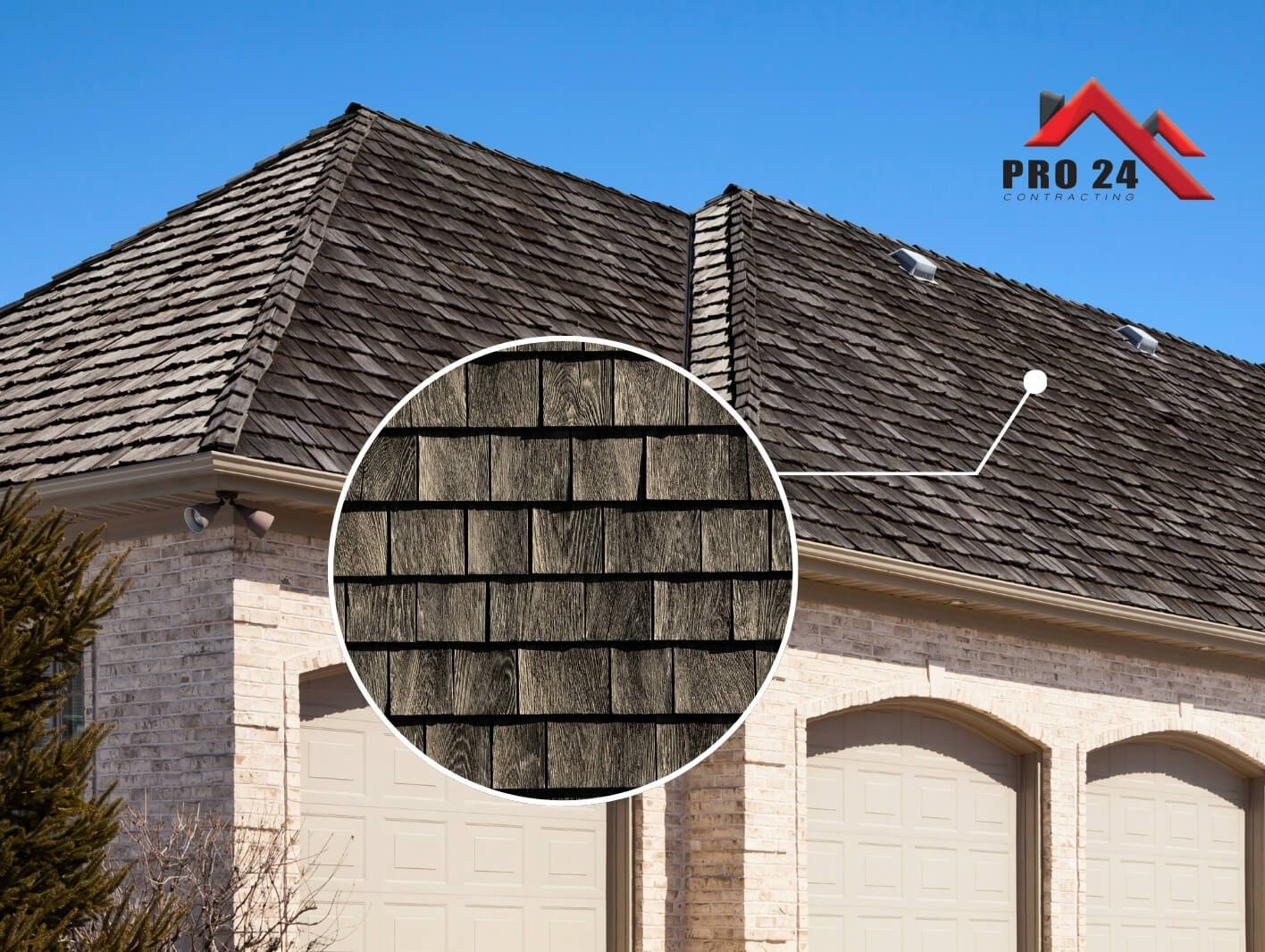Cedar shakes have long been valued for their rustic beauty and natural charm. Crafted from large cedar trees, these shingles add a unique, elegant touch to any home. However, with advancements in roofing technology, synthetic cedar shake roofing has become a popular alternative. As homeowners weigh their options, the debate between natural and synthetic cedar shakes is gaining traction.
In this blog, we’ll compare these two roofing options in terms of lifespan, durability, appearance, cost, and environmental impact to help you decide which cedar shake roof is best for your home.
Understanding Cedar Shake Roofing: A Timeless Choice for Your Home
A natural cedar shake roof is made from split logs of cedar wood, typically sourced from the Pacific Northwest. The shingles are either hand-split or sawn, giving them a rugged texture that has been admired for centuries.
Renowned for their natural beauty and excellent insulation, cedar shakes can last up to 30 years with proper maintenance. However, factors like climate and upkeep play a significant role in determining their actual lifespan.
Synthetic Cedar Shake Roofing: The Modern Alternative to Natural Wood
Synthetic cedar shake roofing, also called composite shake roofing, is engineered to replicate a natural cedar made from polymers or recycled materials. Offering a low-maintenance, durable alternative to wood, synthetic shingles mimic the aesthetic appeal of cedar while eliminating issues like rot, warping, or insect damage. These roofs often last up to 50 years, making them an appealing choice for homeowners seeking long-lasting protection.
Lifespan & Durability: Which Roof Lasts Longer?
Durability and longevity are critical factors when choosing between natural and synthetic cedar shake roofs.
Natural Cedar Shake Roof
With regular maintenance, a natural cedar shake roof typically lasts 25 to 30 years. However, its lifespan can be reduced in humid climates due to moisture, mold, and rot, or in dry climates where the wood may crack and become brittle. Regular cleaning and treatments are necessary to prevent damage.
Synthetic Cedar Shake Roof
Synthetic shakes offer superior durability, withstanding extreme weather conditions like hail, high winds, and UV exposure. These shingles resist rot, cracking, and fading—issues that often plague natural wood. Synthetic roofs typically last between 40 and 50 years, making them one of the most long-lasting roofing materials available.
Appearance & Aging: How Does Each Roof Look Over Time?
Both natural and synthetic cedar shake roofs offer great curb appeal, but their appearance evolves differently over time.
Natural Cedar Shake Roof
Newly installed cedar shakes boast a warm, reddish-brown color that gradually fades to a silvery-gray as the roof ages. While some homeowners appreciate this natural patina, others may prefer the original hue. Over time, natural shakes can curl, crack, or even develop mold, affecting the overall appearance.
Synthetic Cedar Shake Roof
Engineered to retain their appearance for decades, synthetic shakes resist fading, warping, and curling. Offered in a variety of colors and styles, they expertly mimic the texture and grain of natural wood, delivering enduring beauty with minimal maintenance.
Environmental Impact: Which is More Sustainable?
In an era of growing environmental concerns, sustainability is a key consideration for many homeowners.
Natural Cedar Shake Roof
Natural cedar shake roofs are inherently biodegradable and derived from renewable resources, making them environmentally friendly to some extent. However, the harvesting of cedar trees raises deforestation concerns, and the chemicals used to preserve the wood can contribute to environmental pollution.
Synthetic Cedar Shake Roof
Many synthetic cedar shakes come from recycled materials, reducing waste. While these shingles are not biodegradable, their long lifespan means fewer replacements and repairs, minimizing environmental impact. Many manufacturers employ eco-friendly production processes, making synthetic shakes a more sustainable choice overall.
Maintenance: How Much Upkeep Do They Require?
Maintenance requirements are another crucial factor in deciding between natural and synthetic cedar shake roofing.
Natural Cedar Shake Roof
Natural cedar roofs demand consistent maintenance to protect against damage from moisture, mold, and pests. This upkeep includes regularly clearing debris, treating the wood with preservatives, and replacing any damaged shingles promptly.
Neglecting these essential maintenance tasks can result in rapid deterioration of the cedar shakes, compromising the roof’s integrity and leading to expensive repairs down the line.
By investing time and effort into proper care, homeowners can significantly extend the lifespan of their cedar shake roofs and avoid the financial burden of extensive repairs.
Regular inspections and proactive maintenance are key to ensuring your cedar roof remains in optimal condition for years to come.
Synthetic Cedar Shake Roof
Synthetic shakes are highly valued for their exceptional low-maintenance durability, providing robust resistance to moisture, mold, and insect infestations. This resilience means homeowners can enjoy peace of mind without the need for frequent treatments or repairs typically associated with natural materials.
Unlike traditional cedar shakes that require regular upkeep to combat environmental challenges, synthetic cedar shake roofs demand far less attention, making them a hassle-free roofing solution.
While it’s still advisable to conduct occasional inspections to ensure everything is in order, the overall maintenance requirements for synthetic shakes are significantly reduced. Homeowners can benefit from a roofing option that not only retains its aesthetic appeal for years but also saves time and effort on upkeep.
This blend of durability and convenience makes synthetic shakes an attractive choice for those looking for both beauty and practicality in their roofing materials.
Cost Comparison: Which Fits Your Budget?
Both natural and synthetic cedar shake roofs are premium options, but they come with different price points.
Natural Cedar Shake Roof
The average cost of a natural cedar shake roof ranges from $25 to $30 per square foot, with variations depending on factors such as the quality of the wood, the complexity of the installation, and the geographical location of your home. While natural cedar shakes provide a classic and timeless aesthetic that can enhance the overall charm and character of your property, they come with some trade-offs.
One significant consideration is the shorter lifespan compared to alternative roofing materials, which typically ranges between 25 to 30 years with proper care.
Additionally, the maintenance requirements for natural wood are notably higher; homeowners must regularly clean, treat, and inspect their roofs to prevent issues like moisture damage, mold growth, and insect infestations.
These ongoing maintenance needs can result in substantial costs over time, ultimately leading to higher long-term expenses.
Therefore, while the initial investment in a natural cedar shake roof may be appealing for its visual appeal, it’s essential to factor in the potential for increased maintenance and repair costs when evaluating the overall value of this roofing option.
Synthetic Cedar Shake Roof
Synthetic cedar shake roofing is typically more budget-friendly, with costs averaging between $14 and $18 per square foot. While this lower initial investment may be appealing to homeowners, it’s essential to consider the long-term benefits that synthetic shakes offer.
One of the most significant advantages of synthetic cedar shake roofing is its extended lifespan, which can reach up to 50 years with proper installation and care. This durability significantly outpaces that of natural cedar shakes, which usually last between 25 to 30 years.
Additionally, synthetic shakes require minimal maintenance, as they are resistant to issues such as rot, mold, and insect damage. This means homeowners spend less time and money on upkeep, repairs, and treatments over the roof’s life.
When evaluating the overall cost-effectiveness of roofing options, it becomes clear that, despite the higher initial expense of natural cedar shakes, synthetic cedar shake roofing presents a more economical choice in the long run.
The combination of a lower upfront cost, longer lifespan, and reduced maintenance requirements makes synthetic shakes an intelligent investment for homeowners looking for both quality and value in their roofing solutions.
Ultimately, choosing synthetic cedar shake roofing can lead to significant savings and peace of mind, ensuring your home remains protected without the hassle of frequent upkeep.
Choosing the Right Cedar Shake Roof for Your Home
Now that we’ve compared the key factors of natural and synthetic cedar shake roofing, here’s a quick guide to help you choose:
Choose natural cedar shakes if:
- You love the authentic look of wood that evolves over time.
- You don’t mind regular maintenance to preserve the roof’s lifespan.
- You live in a moderate climate that won’t stress the wood too much.
Choose synthetic cedar shakes if:
- You want a low-maintenance, long-lasting roofing solution.
- You prefer a consistent appearance that won’t fade or warp.
- You’re looking for a more budget-friendly option with similar aesthetic appeal.
Both natural and synthetic cedar shake roofs come with their own unique advantages, allowing homeowners to select a roofing option that best fits their specific needs and preferences.
Your ultimate decision will hinge on several key factors, including your personal style, budget constraints, and the climate conditions prevalent in your area.
Natural cedar shakes are celebrated for their timeless elegance, offering a classic look that enhances the character of any home. The rich, warm tones and unique textures of natural wood create a stunning visual appeal that many homeowners find irresistible.
However, this beauty comes with certain responsibilities, including regular maintenance and care to ensure the roof remains in optimal condition over the years.
On the other hand, synthetic cedar shake roofing provides a modern alternative with its impressive durability and low-maintenance requirements. Designed to replicate the aesthetic of natural wood, synthetic shakes deliver a sleek and polished appearance without the ongoing upkeep demands associated with real cedar.
This makes them an appealing choice for busy homeowners who want to enjoy the beauty of a cedar shake roof without the hassle.
The Bottom Line
Ultimately, whether you opt for the natural cedar’s timeless charm or the contemporary resilience of synthetic shakes, both options can significantly enhance your home’s aesthetic while providing reliable protection against the elements.
By carefully considering your personal preferences, budget, and local climate, you can make an informed choice that not only elevates your home’s curb appeal but also ensures long-lasting performance and peace of mind.
At Pro 24 Contracting, we’re experienced in installing both natural and synthetic cedar shake roofs. Contact us today for a consultation, and let our team help you find the perfect roofing solution for your home!

